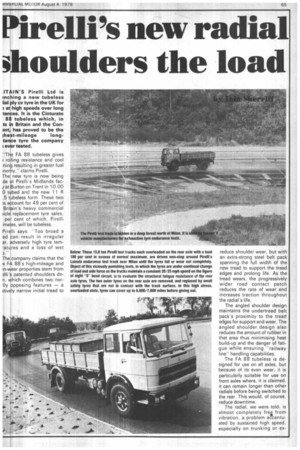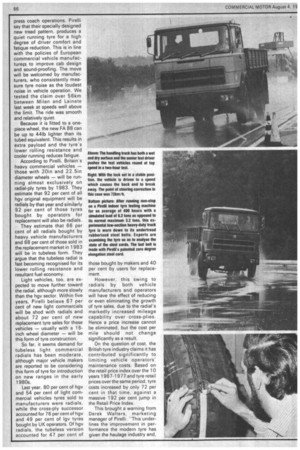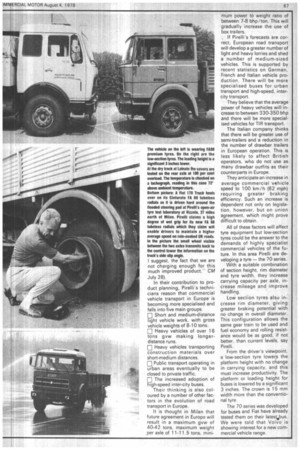Pirelli's new radial ihoulders the load
Page 67

Page 68

Page 69

If you've noticed an error in this article please click here to report it so we can fix it.
ITAIN'S Pirelli Ltd is inching a new tubeless lial ply cv tyre in the UK for a at high speeds over long lances. It is the Cinturato 88 tubeless which, in ts in Britain and the Conant, has proved to be the
phest-mileage longtance tyre the company ; ever tested.
"The FA 88 tubeless gives r ro ling resistance and cool ifling resulting in greater fuel inorny,claims Pirelli.
The new tyre is now being de at Pirelli's Midlands fac,/ at Burton on Trent in 10.00 0 tubed and the new 11 R .5 tibeless form. These two ts account for 49 per cent of Britain's heavy commercial iicle replacement tyre sales, pecent of which, Pirelli 'males, will be tubeless.
Pirelli says "Too broad a ad can result in irregular ar, adversely high tyre tern-atures and a loss of wet
D.—
The company claims that the nt FA 88's high-mileage and in-wear properties stem from alli's patented shoulders den, which combines two norIly opposing features — a itivEly narrow initial tread to reduce shoulder wear, but with an extra-strong steel belt pack spanning. the full width of the new tread to support the tread edges and prolong life. As the tread wears, the progressively wider road contact patch reduces the rate of wear and increases traction throughout the radial's life.
The angled shoulder design maintains the undertread belt pack's proximity to the tread edges for support and wear. The angled shoulder design also reduces the amount of rubber in that area thus minimising heat build-up and the danger of fatigue While ensuring "railway line" handling capabilities.
The FA 88 tubeless is designed for use on all axles, but because of its even wear, it is particularly suitable for use on front axles where, it is claimed, it can remain longer than other radials before being switched to the rear, This would, of course, reduce downtime.
The radial, we were told; is almost completely fre4 from vibration, a problem accentuated by sustained high speed, especially on trunking or ex press coach operations. Pirelli say that their specially designed new tread pattern, produces a quiet running tyre for a high degree of driver comfort and fatigue reduction. This is in line with the policies of European commercial vehicle manufactures, to improve cab design and sound-proofing. The move will be welcomed by manufacturers, who consistently measure tyre noise as the loudest noise in vehicle operation. We tested the claim over 56km between Milan and Lainate last week at speeds well above the limit. The ride was smooth and relatively quiet.
Because it is fitted to a onepiece wheel, the new FA 88 can be up to 44Ib lighter than its tubed equivalent. This results in extra payload and the tyre's lower rolling resistance and cooler running reduces fatigue.
According to Pirelli, Britain's heavy commercial vehicles — those with 20in and 22.5in diameter wheels — will be running almost exclusively on radial-ply tyres by 1983. They estimate that 92 per cent of all hgv original equipment will be radials by that year and similarly 92 per cent of those tyres bought by operators for replacement will also be radials.
They estimate that 66 per cent of all radials bought by heavy vehicle manufacturers and 68 per cent of those sold in the replacement market in 1983 will be in tubeless form. They argue that the tubeless radial is fast becoming recognised for its lower rolling resistance and resultant fuel economy.
Light vehicles, too, are expected to move further toward the radial, although more slowly than the hgv sector. Within five years, Pirelli believe 67 per cent of new light commercials will be shod with radials and about 72 per cent of new replacement tyre sales for these vehicles — usually with a 16inch wheel diameter — will be this form of tyre construction.
So far, it seems demand for tubeless light commercial radials has been moderate, although major vehicle makers are reported to be considering this form of tyre for introduction on new ranges in the early 1980s.
Last year, 80 per cent of hgv and 54 per cent of light commercial vehicles tyres sold to manufacturers were radials, while the cross-ply successor accounted for 76 per cent of hgv and 49 per cent of lgv tyres bought by UK operators. Of hgv radials, the tubeless version accounted for 47 per cent of those bought by makers and 40 per cent by users for replacemerit.
However, this swing to radials by both vehicle manufacturers and operators will have the effect of reducing or even eliminating the growth of tyre sales, due to the radial's markedly increased mileage capability over cross-plies. Hence a price increase cannot be eliminated, but the cost per mile should not change significantly as a result.
On the question of cost, the British tyre industry claims it has contributed significantly to limiting vehicle operators' maintenance costs. Based on the retail price index over the 10 years 1 967-1 977 and tyre retail prices over the same period, tyre costs increased by only 72 per cent in that time, against a massive 192 per cent jump in the Retail Price Index.
This brought a warning from Derek Walters, marketing manager of Pirelli "This underlines the improvement in performance the modern tyre has given the haulage industry and,
I suggest, the fact that we are not charging enough for this much improved product.CM July 28).
In their contribution to product planning, Pirelli's techni cians reason that commercial vehicle transport in Europe is becoming more specialised and falls into five main groups.
111 Short and medium-distance light vehicle work, with gross vehicle weights of 8-10 tons. F-1 Heavy vehicles of over 16 tons gvw making longerdistance runs.
111 Heavy vehicles transporting construction materials over short-medium distances.
Public transport operating in urban areas eventually to be closed to private traffic.
1:1 The increased adoption of high-speed inter-city buses.
Their thinking is also coloured by a number of other factors in the evolution of road transport in Europe.
It is thought in Milan that future agreement in Europe will result in a maximum gvw of 40-42 tons, maximum weight per axle of 11-11.5 tons, mini
mum power to weight ratio of between 7-8 bhp/ton. This will gradually increase the use of box trailers.
If Pirelli's forecasts are correct, European road transport will develop a greater number of light and heavy lorries and shed a number of medium-sized vehicles. This is supported by recent statistics on German, French and Italian vehicle pro duction. There will be more specialised buses for urban transport and high-speed, intercity transport.
They believe that the average power of heavy vehicles will in crease to between 330-350 bhp and there will be more specialised vehicles for TIR transport.
The Italian company thinks that there will be greater use of semi-trailers and a reduction in the number of drawbar trailers in European operation. This is less likely to affect British operators, who do not use as many drawbar outfits as their counterparts in Europe.
They anticipate an increase in average commercial vehicle speed to 100 km/h (62 mph) requiring greater braking efficiency. Such an increase is dependent not only on legislation, however, but on union agreement, which might prove difficult to obtain.
All of these factors will affect tyre equipment but low-section tyres could be the answer to the demands of highly specialist commercial vehicles of the future. In this area Pirelli are developing a tyre — the 70 series.
With a suitable combination of section height, rim diameter and tyre width, they increase carrying capacity per axle, increase mileage and improve handling.
Low section tyres also increase rim diameter, giving greater braking potential with no change in overall diameter. This configuration allows the same gear train to be used and fuel economy and rolling resistance would be as good, if not better, than current levels, say Pirelli.
From the driver's viewpoint, a low-section tyre lowers the platform height with no change in carrying capacity, and this must increase productivity. The platform or loading height for buses is lowered by a significant 3 inches. The crown is 15 mm width more than the conventional tyre.
The 70 series was developed for buses and Fiat have already tested them on their latestabus. We were told that Volvo is showing interest for a new commercial vehicle range.




















































































































